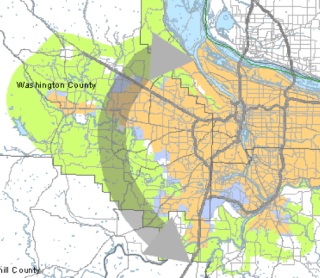
In a move that can be described as nothing less than audacious, Hillsboro Mayor Jerry Willey is leading an effort to receive a legislative mandate to move forward on studying a mega-project now being calling the “Westside Transportation Corridor.”
The project is a re-hash of the long-debated Westside Bypass that would create a new freeway system that would be an alternative to I-5 and I-205 and would stretch from Wilsonville in the south to Highway 30 at the Columbia River in the north. The freeways would run through significant swaths of key rural areas and farms in Washington and Yamhill counties.
The bypass project has been debated since the late 1980s, when it was vehemently opposed by land-use watchdogs 1000 Friends of Oregon and other groups. They ultimately won that battle, but it appears the fight is set to start again very soon. (Interestingly, a story just last May in The Oregonian wondered whether or not it was actually dead and Willey seemed dismissive of its chances at resurrection.)
Mayor Willey has commissioned a white paper (PDF) on the project detailing why he and his supporters feel the new freeways are necessary. In a nutshell, the project is being pitched as a crucial investment to combat congestion, create jobs, and to improve economic development in the region.
Here’s some of the language from the white paper:
“2010 afternoon peak hour traffic conditions in 2010 reflect high levels of congestion in the key Westside corridors… by 2035, these conditions are expected to become significantly worse… Significant traffic growth and higher levels of congestion are anticipated on the key Westside connections US 26 (Sylvan) and Highway 217. The period peak congestion spreads further into the mid-day hours (much more than it does today).
Many of the suburban and rural highways that link Hillsboro, Cornelius and Forest Grove with Beaverton, Tualatin, Tigard and Wilsonville, will experience heavy congestion. These routes were not designed and built to withstand the growth in urban commuter and freight mobility demand expected in the future. Traffic safety will be an obvious, key concern on these routes.”
Instead of going through the usual land use planning process for a project of this size, Willey is seeking a legislative mandate. He has already drafted bill language he intends to push through the 2013 legislative session that would mandate funding for a study of the project.
The bill reads:
“… directing the Oregon Department of Transportation to undertake and complete a planning and feasibility study of a potential, new transportation corridor to serve the long-term mobility and freight needs of northwest Oregon communities; and, allocating money.
… The Department of Transportation shall undertake a long-term planning and feasibility study of a new, alternative state highway corridor route, and associated, supporting state and regional highway projects, west of Oregon Route 217 running north and south through Washington County and portions of Multnomah and Clackamas Counties and connecting to US Interstate Highway 5 at its north terminus approximately at Highway 30 and at its south terminus near the City of Wilsonville.”
Willey has informed mayors and commissioners from throughout the region about his plans. In a letter dated November 7th, 2012 (PDF), he foresees the challenges of pushing such a controversial project:
“We know full well, that the concept of a Westside travel corridor, that can perform freight and mobility bypass functions similar to the I-205 corridor, will draw vehement (and sometimes harsh) opposition/criticism from some communities and various interest groups within and outside the Portland Region: Its costs and impacts on agriculture activists and natural resources/amenities located within/along such a corridor would be huge.
But, it will have equally strong support from other communities and business groups whose concerns about Westside freight movement delays and travel congestion along Hwy 26, Hwy 217, an I-5/99W travel shed and connecting State and regional arterials are already at a high level. Their concerns would reach crisis level if a steadily increasing potential of day-long traffic clogs and delays along these Westside freight and mobility routes is ever reached as forecasted population and economic growth throughout northwest Oregon over the next 20-30 years become reality.
The long-standing, recurring debate about the merits of the Westside corridor belies a simple truth — in our view: We’ve reached a time in this ongoing debate for the State/ODOT to honestly and empirically evaluate the need and economic, environmental, societal, and quality-of-life merits of eventually providing a Westside Corridor.”
This is a serious proposal that, as Willey rightly points out, will galvanize opposition. Has the political environment changed since this was fought back in the 1980s? It’s interesting to note that freeway projects have been gaining steam lately. Both Metro and PBOT have green-lighted freeway expansions of late. Also consider that the former mayor of Hillsboro, Tom Hughes, is now president of Metro and he has been touting a “jobs, jobs, jobs” and economic development focus from Day One.
This could get interesting. Stay tuned.
Learn more:
— From The Oregonian, May 31st, 2012: Washington County officials and others ponder whether the westside bypass is really dead
— “Transportation Infrastructure and Westside Economy” (A Westside Corridor Concept White Paper (PDF)
— Memo from Hillsboro Mayor Jerry Willey to regional leaders (PDF)

